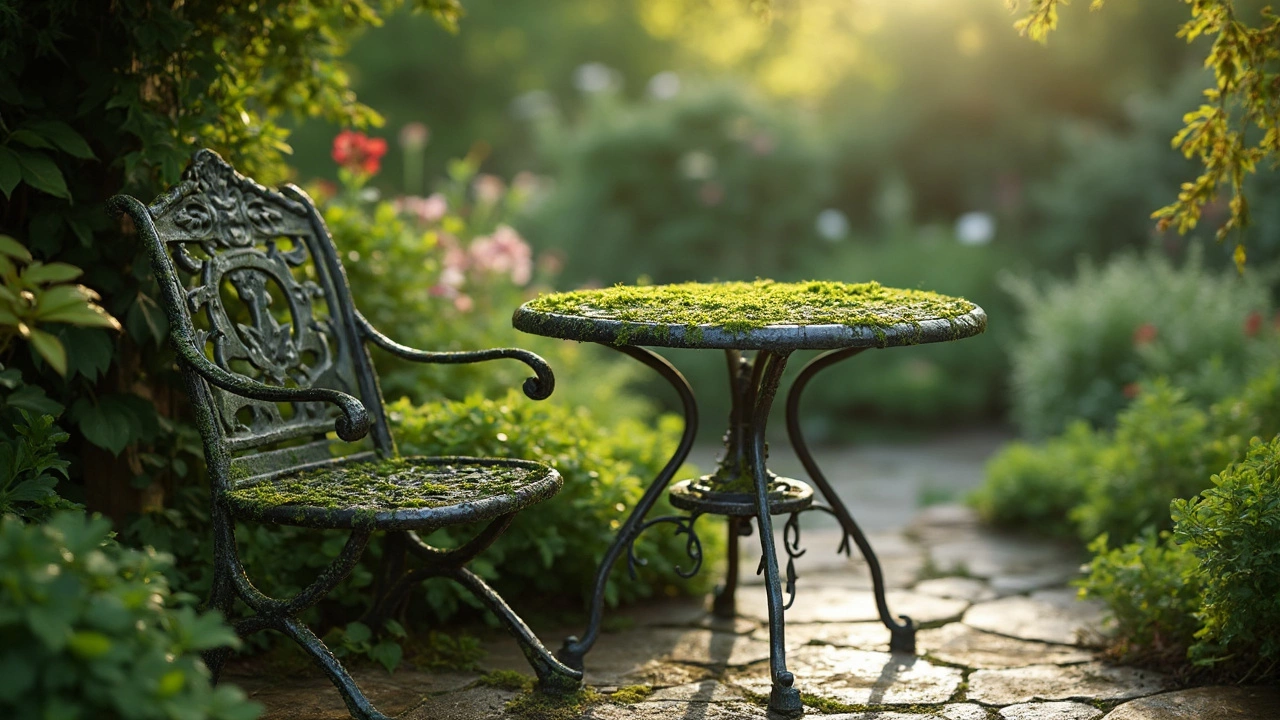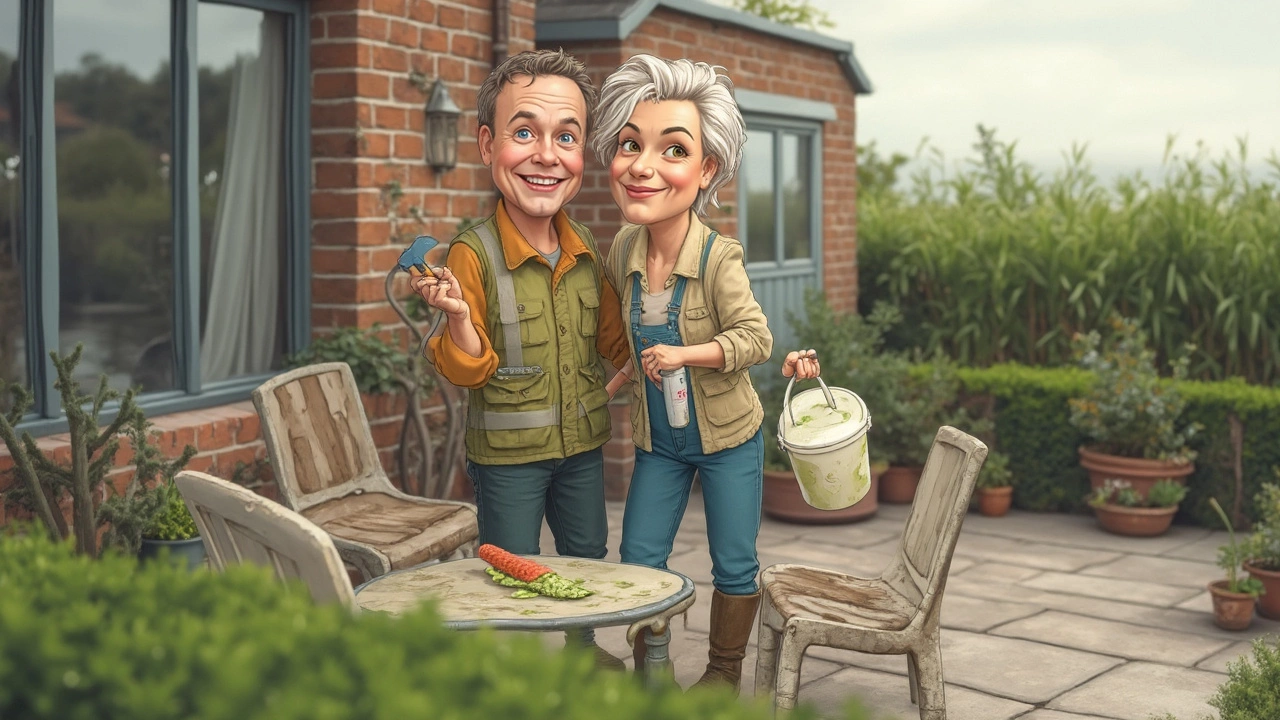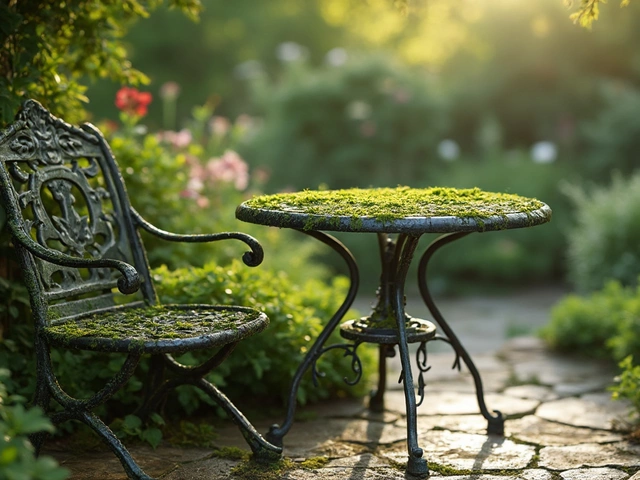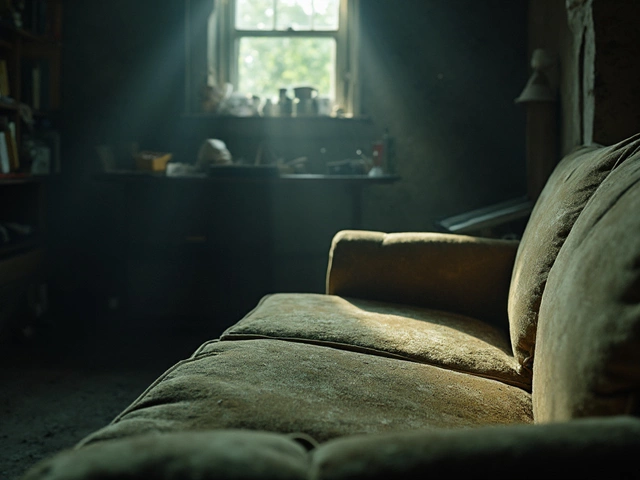Green Stuff on Patio Furniture: What It Is and How to Get Rid of It

Spotting that green gunk on your patio furniture is annoying—and a little gross. That green stuff isn’t just some harmless grime you can wipe away with your finger. Nine times out of ten, you’re looking at a mix of mold, mildew, and algae. These guys love outdoor furniture, especially when it gets damp, stays shaded, or just doesn’t dry out fast enough after a rain.
It’s not just about looks, either. Mold and algae can actually weaken the surfaces of your chairs and tables, especially if you’ve got wood or wicker pieces out back. Over time, if you ignore it, what started as a tiny spot can turn into streaks or patches that eat away at finishes, make your cushions smell musty, or even start sneaking inside the house on your shoes or clothes.
Good news? You don’t need fancy chemicals or a pressure washer to fix this. With some basic household stuff (think white vinegar and a brush), you can get most of the green nastiness off in an afternoon. Stick around for some easy fixes and long-term tricks to keep those green patches from coming back every spring.
- What Is the Green Stuff?
- Why It Shows Up on Patio Furniture
- Easy Ways to Clean the Green Away
- Tips to Keep It from Coming Back
What Is the Green Stuff?
Let’s cut to it: that green stuff on your patio furniture isn’t just dirt. Most of the time, it’s actually a mix of algae, mold, and mildew. These living things show up as either powdery patches, slimy coats, or dots that spread, sometimes in cool patterns, sometimes just making everything look grimy.
Algae is the most common offender, especially if your yard or patio stays damp and shady. It’s a simple plant, not picky about where it grows. It shows up as bright or dark green stains, mainly on hard surfaces—plastic chairs, glass tables, or old wooden benches.
Now, if what you spot feels fuzzy or smells a bit like an old basement, that could be mold or mildew. Mold prefers to make itself at home on fabric cushions, umbrellas, and even wood—especially those that don’t dry out in the sun. Mildew, which is just a certain kind of mold, gives off a light gray-green powdery look. Both love moisture and warmth, which is why they thrive after rain or humid days.
Check out how these troublemakers compare:
| Type | Typical Look | Likes to Grow On | Smells? |
|---|---|---|---|
| Algae | Slippery, bright/dark green streaks or patches | Plastic, glass, metal, stone | No |
| Mold | Fuzzy green/black spots | Wood, cushions, fabric | Yes (musty) |
| Mildew | Pale green, grayish powdery coating | Fabrics, wood, vinyl | Light, sometimes sweetish |
Letting these guys hang out on your furniture is bad news. Besides being ugly, mold and mildew can trigger allergies if you’re sensitive, or just leave your backyard smelling funky. That’s why catching it early and knowing exactly what you’re dealing with is the first step in getting your patio furniture back in shape.
Why It Shows Up on Patio Furniture
The green stuff that likes to camp out on your patio chairs and tables is mostly mold, mildew, or algae. These guys are basically nature’s cleanup crew. They pop up whenever there’s enough moisture, a bit of shade, and something to latch on to—like the surface of your favorite deck chair.
This happens more often than you think, especially if you leave your patio furniture out through the seasons. Here’s what gets the green invasion started:
- Dampness: Rain, morning dew, or high humidity can soak into cushions and even metal. Mold and algae love wet and damp stuff.
- Lack of Sunlight: The shadier the spot, the more likely you are to get those green stains. Sunlight kills off a lot of the spores and algae naturally.
- Dirt and Organic Debris: Tiny bits of leaves, tree sap, pollen, and bird droppings are food for mold, mildew, and algae.
- Warm Temperatures: These pests really start to party once temps get above 60°F (about 15°C). That’s why you’ll see more of it in spring and summer.
Check out this quick breakdown of when you’re most likely to see the green stuff:
| Condition | Risk Level for Green Stuff |
|---|---|
| Shady, damp, dirty | Very high |
| Sunny, dry, clean | Low |
| Warm spring/summer | High |
| Cold winter | Low (but returns in spring if not cleaned) |
Some types of mold and algae can even spread just by the wind blowing spores around, or by someone moving a cushion or table that’s already contaminated. If one piece of furniture gets infected, it always seems like the problem spreads overnight. That’s why regular cleaning is your best defense, not just for looks, but for your furniture’s life span.

Easy Ways to Clean the Green Away
If your patio furniture looks like it’s growing a green beard, you don’t have to toss it. Most people have what they need right in their kitchen or garage. Vinegar, baking soda, and even dish soap cut through mold, mildew, and algae way better than plain water alone.
Start with a simple cleaning mix. Here’s what works for most messes:
- Mix equal parts white vinegar and water in a spray bottle. No vinegar? You can use a bit of regular dish soap in warm water instead.
- Spray the solution all over the green spots. Don’t hold back—the idea is to soak the trouble areas.
- Let it sit for about 15-20 minutes. This gives the mix time to break down the green stuff so your scrubbing job isn’t backbreaking.
- Scrub using a soft-bristled brush. Plastic brushes are best; avoid anything metal, which can scratch your furniture.
- Rinse off with a hose or a bucket of clean water. Then, let it dry completely in the sun. Sunshine helps kill off any leftover mildew or mold spores.
For stubborn stains, sprinkle a little baking soda directly onto a wet sponge and scrub the spot. This gives extra scrubbing power without damaging your furniture’s surface. If there’s mildew on fabric or cushion covers, check the tags first—most removable covers can handle a wash in hot water with a cup of vinegar in the cycle.
The EPA points out that vinegar kills at least 80% of mold types found on outdoor surfaces. But if you see big black areas or a funky smell that won’t go away, it’s best to use a commercial mold remover (just make sure it’s labeled safe for outdoor furniture material—whether it’s plastic, wood, or metal).
| Cleaner | Works On | Safe for |
|---|---|---|
| White Vinegar | Mold, Mildew, Algae | Wood, Metal, Plastic |
| Baking Soda | Stains, Odors | All Surfaces |
| Dish Soap | Light Green Residue | All Surfaces |
| Commercial Mold Remover | Stubborn Mold & Mildew | Check Label |
Don’t forget gloves when scrubbing just in case you’re sensitive to mold or cleaners. If that green gunk keeps showing up within a couple of weeks, there might be an issue with drainage, sun exposure, or humidity you’ll want to tackle—which is another story.
Tips to Keep It from Coming Back
If you’re tired of dealing with green stuff on your patio furniture, a few smart moves can keep that mold, mildew, and algae at bay. It’s not about scrubbing nonstop—it’s about building simple habits and using cheap supplies. Here’s what actually works.
- Let your furniture dry out. Mold and algae thrive in dampness, so if you can, put your chairs and tables somewhere the sun hits them for a few hours after it rains. Even plastic and metal need to dry out once in a while.
- Wipe furniture down every couple of weeks. A quick wipe with a dry cloth can help a lot, especially after wet weather. For wood, use a soft, dry rag. For metal or plastic, sometimes just a microfiber cloth is enough.
- Cover up or store your furniture when not in use. If you don’t want surprises next spring, invest in basic patio covers or stash chairs in a shed or garage for the winter. Keep covers tight and off the ground so air can circulate.
- Clean furniture once a month, even if it looks fine. Mix one part vinegar with three parts water and spray or wipe it down to keep spores from taking hold. Don’t forget to rinse afterwards if you’ve got metal—it stops corrosion in its tracks.
- Trim bushes and trees nearby. Less shade means less moisture and less opportunity for algae or mildew to move in. If your furniture lives under a tree, consider moving it or trimming branches to let in more sun and airflow.
- Watch for nearby water sources. Got a sprinkler that hits the same patio spot all the time? Muddy shoes tracking water onto plastic chairs? Change up the routine so water isn’t hanging around where you lounge.
Check out the common triggers for green growth in this quick table:
| Trigger | Why It Matters |
|---|---|
| Constant moisture | Encourages mold/algae spores to take hold |
| Poor sunlight | Keeps surfaces damp for longer |
| Lack of airflow | Makes drying out tough |
| Dirty surfaces | Spores stick and multiply easier |
Staying one step ahead with these habits will save you way more effort (and money) than dealing with a full-blown green takeover. Your outdoor space will stay fresher and last longer, no matter what the weather throws at it.

